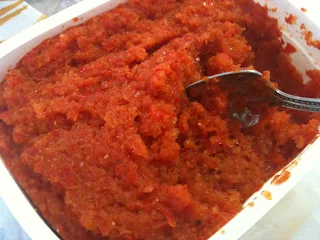
Hokkien mee, or har mee or mee yoke, all refer to a much beloved dish that depends so much on the inherent quality of a great stock soup (image below). The prawns or shrimps (har) must be fresh, have a zesty bite to the taste and are used, not just as an ingredient in the finished product to serve, but also in contributing to the nuances of the soup. The mee refers to the noodles of your choice (above image) but they do affect the overall experience (for example, slurpiness like in eating ramen, or a different texture, as in pasta). The yoke are the thinly cut slices of pork rib meat, with some layer of fat, essential to the aroma and wholesomeness of this dish.


A favourite of southern Chinese street food, and also in South-east Asia, is the use of deep fried shallots or cut onion rings (below) to accompany the har mee yoke. All images here were taken at the kitchen of Susan and Boo Ann Yap in Carlingford, Sydney, in a joint cooking session with one of my cousins, Mu Lan.


The quality, intensity and texture of the chili paste (picture below) results from carefully selecting the type of chilies, plus the addition of garlic and shallots to taste.
Suggested Recipe, from RasaMalaysia:
Soup Stock ingredients:
1 ziplock bag of shrimp heads and shells (I used Ziplock Easy Zipper Bag)
Soup Stock ingredients:
1 ziplock bag of shrimp heads and shells (I used Ziplock Easy Zipper Bag)
15 cups of water (reduced to about 12-13 cups of water after hours of boiling and simmering)
2-3 pieces of rock sugar (about the size of a small ping pong ball) or to taste
1.5 lbs of pork ribs (cut into pieces)
Salt to taste
Chili Paste:
30 dried chilies (de-seeded and soaked to soften)
10 shallots (peeled)
5 cloves garlic (peeled)
2 tablespoons of water
Other Ingredients Required:
6 tablespoons of cooking oil
1 pound of yellow noodles or mee (scalded)
1 pound of yellow noodles or mee (scalded)
1 pack of rice vermicelli (scalded)
Some kangkong or water convolvulus (scalded)
Some bean sprouts (scalded)
Toppings:
1/2 pound of lean pork meat (boiled and sliced thinly)
1/2 pound shrimp or prawns (shelled and de-veined)
6 hard-boiled eggs (shelled and quartered)
Some fried shallot crisps
Method and Approach:
Blend the chili paste ingredients with a mini food processor until they are finely ground and well blended.
Heat up the wok and add cooking oil.
Stir fry the chili paste for 5 minutes. Dish up and set aside.
On the same wok (unwashed), add in a little oil and cook the shrimp topping. Add in a little chili paste, sugar, and salt. Pan-fried the shrimp until they are slightly burned. Dish up, let cool and sliced them into halves.
Add 15 cups of water into a pot and bring it to boil.
Add in all the shrimp or prawn heads and shell and simmer on low heat for about 2 hours or longer, until the stock becomes cloudy and tastes really prawny.
Strain the stock through sieve and transfer the stock into another pot. Discard the prawn or shrimp heads and shells. Scoop up and discard the orange coloured “foam” forming at the top of the stock.
Bring the stock to boil again and add in half of the chili paste. You can add more chili paste if you like it spicier.
Add in the pork ribs and continue to boil in low heat for another 1-1.5 hour until the pork ribs are thoroughly cooked.
Add rock sugar and salt/fish sauce to taste.
To Serve:
To serve, place a portion of yellow noodles, rice vermicelli, water convolvulus and bean sprouts in a bowl. Ladle the hot stock over. If desired, add a few pieces of pork ribs. Top up with meat slices, sliced shrimp, hard boiled egg quarters - and sprinkle with shallot crisps.
Serve immediately with more chili paste to taste.
Cook’s notes:
Traditionally, the prawn or shrimp heads and shells are stir-fried with oil until aromatic before adding them into the boiling water.
The hawkers in Penang also blended the prawn or shrimp heads and shells after they are briefly boiled to extract all the flavors from the shell.
Traditionally, the prawn or shrimp heads and shells are stir-fried with oil until aromatic before adding them into the boiling water.
The hawkers in Penang also blended the prawn or shrimp heads and shells after they are briefly boiled to extract all the flavors from the shell.





No comments:
Post a Comment